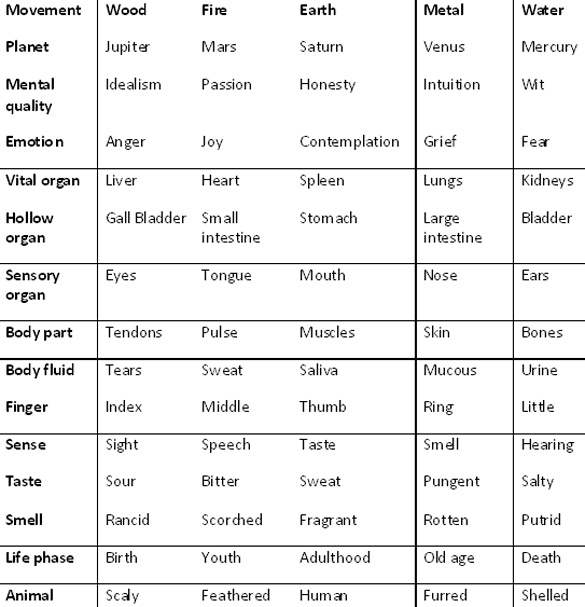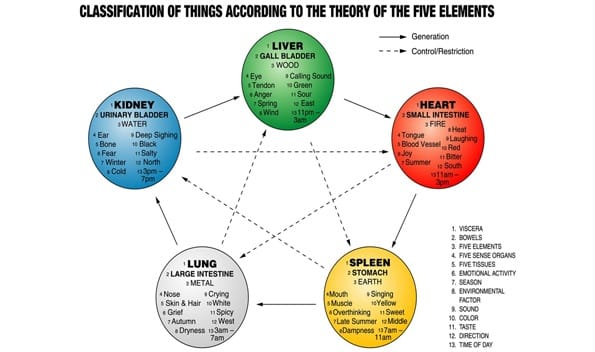The foundations of traditional Chinese medicine dates back some five thousand years. The concept of Yin/Yang, together with the five elements, has permeated Chinese philosophy over the centuries and is radically different to any western philosophical idea. The earliest reference to Yin/Yang is in the “Book of Changes” dating back to about 700BC. In this book Yin and Yang are represented as broken and unbroken lines. The combinations of these form the eight trigrams. Finally, the various combinations of the trigrams give rise to the sixty-four hexagrams. These are supposed to symbolize all possible phenomena of the universe, and it therefore shows how all phenomena ultimately depend on the two poles of Yin and Yang. The diagram below shows the configuration of the eight trigrams in relation to nature.
The concept of Yin/Yang is probably the single most important and distinctive theory of Chinese Medicine. It could be said that all Chinese medical physiology, pathology and treatment can, eventually, be reduced to Yin and Yang. The concept of Yin/Yang is extremely simple yet very profound.
Together with the theory of Yin/Yang, the theory of the five elements constitutes the basis of Chinese Medical theory. The early Greek philosophers such as Empedocles called the elements “roots”. Plato referred to them as “simple components” and Aristotle called them “primary form”. Whatever words were used, the Greek philosophers were unified that the elements were the basic building blocks or constituents in describing the qualities of natural phenomena. The system of five phases was used for describing interactions and relationships between phenomena. After it came to maturity in the second or first century BC during the Han Dynasty, this device was employed in many fields of early Chinese thought, including seemingly disparate fields such as geomancy, Feng Shui, astrology, traditional Chinese medicine, music, military strategy, and the martial arts. The system is still used as a reference in the martial arts like Qi Gong, Kung Fu, and Tai Chi.
The Elements
The five elements are usually used to describe the state in nature.
- Wood/Spring: (72 days) A period of growth, which generates abundant wood and vitality
- Fire/Summer: (72 days) A period of swelling, flowering, brimming with fire and energy
- Earth: (72 days = 4 x 18 days; 4 transitional seasons of 18 days each) The in-between transitional seasonal period, or a separate ‘season’ known as late summer or long summer – the latter case associated with levelling and dampening and fruition
- Metal/Autumn: (72 days) A period of harvesting and collecting
- Water/Winter: (72 days) A period of retreat where stillness and storage pervades
The doctrine of five phases describes two cycles; a generating or creation cycle, whereby water generates wood, wood generates fire, fire generates earth, earth generates metal, and metal generates water. The second cycle is called the controlling cycle whereby water controls fire, fire controls metal, metal controls wood, wood controls earth, and earth controls water. The mutual generating and controlling relationships among the elements is a fine model of the balancing processes to be seen in nature and the human body.
The following diagram shows the five elements and their corresponding relationships within the human framework. Each element represents a solid vital organ, a hollow bowel, the five senses, five tissues, five pure emotions, the corresponding season, environmental factor, the five sounds, five colours, five tastes/flavours, direction, and time of day (activity).
The diagram above shows corresponding patterns in cyclic form, and the table below shows the patterns in linear forms.
The physical and emotional aspects of the five vital organs
The Heart
The heart is considered to be the most important of all the internal organs, and is said to be the ‘ruler’ or ‘monarch’ that resides over the internal organs. The physical functions of the heart are to govern blood, control the blood vessels, manifest in the complexion, houses the mind, opens into the tongue, and controls sweat. The emotional aspect relates to mental activity. If the heart is strong with abundant blood, there will be normal mental activity, a balanced emotional life, clear consciousness, a good memory, clear thinking and good sleep. If the heart is weak and blood deficient then there may be mental problems such as anxiety, depression, poor memory, dull thinking, and insomnia with dream-disturbed sleep.
The Liver
The liver is often compared to an army general from where the strategy is derived, hence courage and resoluteness manifest from the liver. The physical functions of the liver are to store blood, ensure the smooth flow of energy, moistens the sinews, opens into the eyes. The emotional aspect relates to the smooth flow of energy and blood. Long periods of unresolved anger, resentment and frustration can stagnant the flow, leading to stiff tight muscles, digestive disturbances, menstrual problems in women, and thinking becomes dull and foggy.
The Lungs
The lungs are like a minister from where the policies are issued. The physical functions of the lungs are to govern energy and respiration, control dispersing and descending the energy, regulate water passages, control skin and hair, and open into the nose. The emotional aspect relates to long periods of unresolved grief and sadness, which constrains the lungs leading to shallow breathing to the top lobes of lungs.
The Spleen
The spleen is like a granary official from whom the five tastes are derived. The physical functions of the spleen are to govern transformation and transportation, control blood, control muscles and the four limbs, opens into the mouth and lips. The emotional aspect relates to thought; if the health of the spleen is abundant we will think clearly, concentrate and memorize easily. Conversely, excess studying and mental work or agitation over long periods can weaken the spleen.
The Kidneys
The kidneys are referred to as the root or gate of life, as they govern essence from our parents. They control birth, growth, reproduction, and development, producing marrow for the bones and brain. The emotional aspect relates to fear and willpower. Long periods of fear can weaken the kidneys and lead to a loss of will power. Working long hours with stress also weakens kidney energy.




